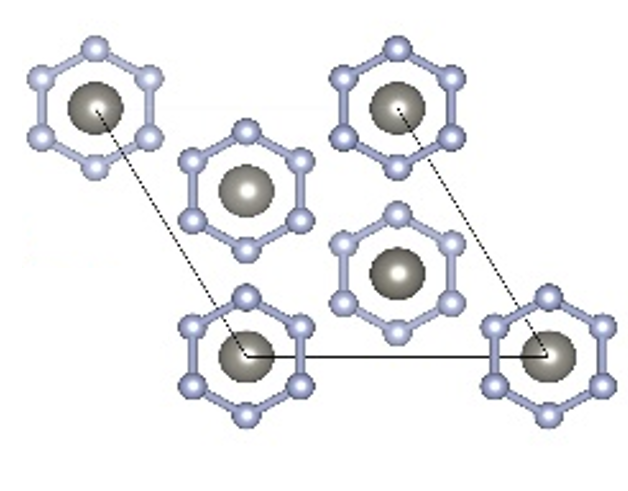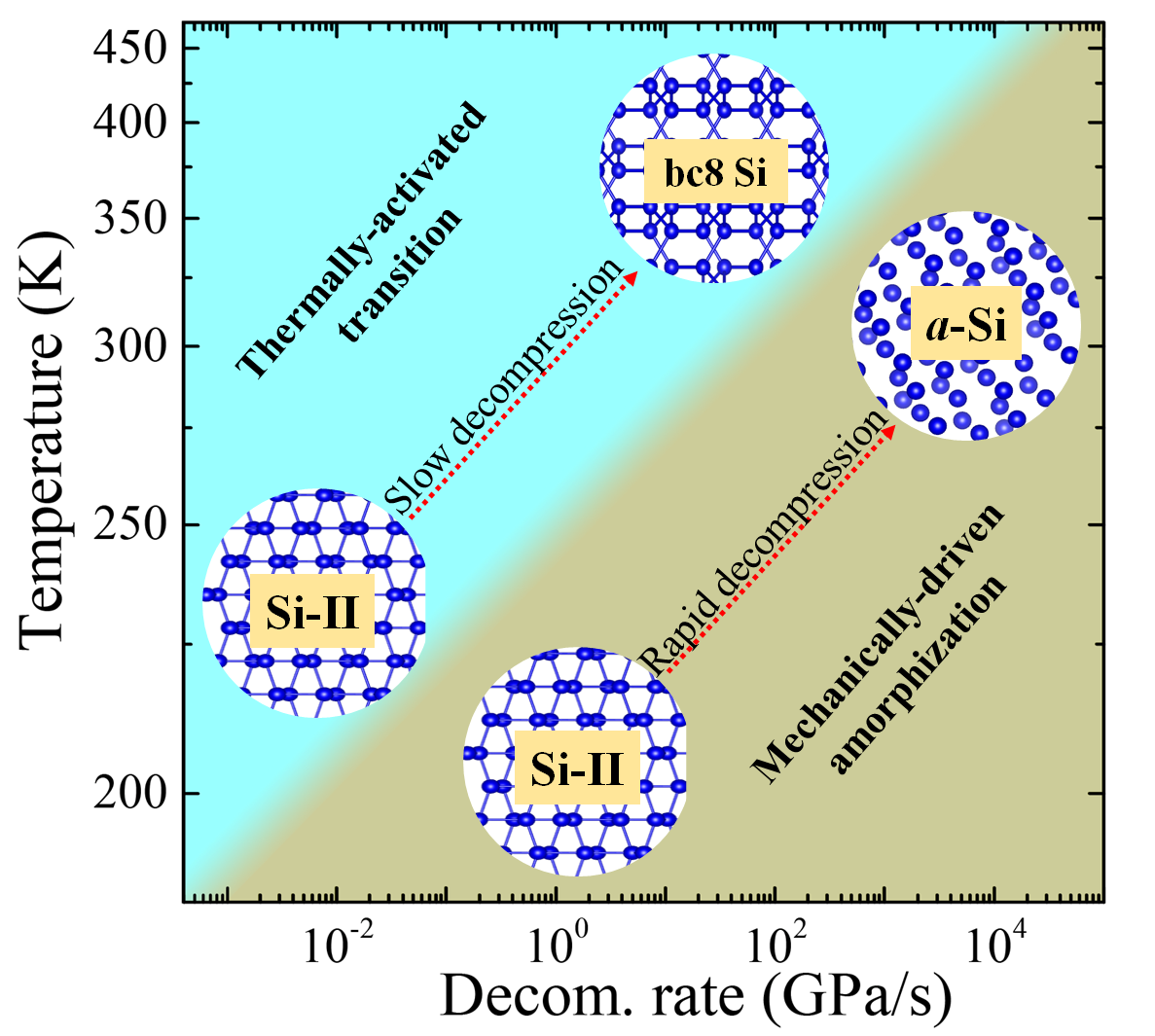

SEPTEMBER 6, 2021 — In a truly international effort, a team of scientists based in Japan, Australia, UK, USA and China have uncovered the high-pressure behavior of hydrogen chloride (HCl). The project, which was led by Dr. Philip Dalladay-Simpson of HPSTAR, details the significant role that hydrogen still plays even after the pressure-induced symmetrisation of the hydrogen bond in HCl. The team’s...

JULY 23, 2021 — New work from a team of scientists led by Dr. Haiyan Zheng and Dr. Kuo Li from HPSTAR found the ethynylphenyl of 1,3,5-triethynylbenzene (TEB) undergoes [4 + 2] dehydro-Diels−Alder (DDA) reaction with phenyl at 4 GPa. Their study suggested that the DDA reaction between ethynylphenyl and phenyl is a promising route to decrease the reaction pressure of aromatics, which allows the...

JULY 19, 2021 — A team of HPSTAR scientists led by Dr. Mingxue Tang has developed Stöber sol-gel method and in-shell sulfuration method craft γ-Ce2S3 nanoparticles in hollow mesoporous carbon shell with tunable voids to buffer the volume change upon electrochemical cycling for the first time. The synergetic effects of nanosized Ce2S3 core and the coating carbon shell with enhanced electronic...

JUNE 15, 2021 — A team of HPSTAR scientists led by Dr. Yang Ding and Dr. Hongshan Deng has solved a thirty-year mystery regarding the insulator-to-metal transition in the quantum molecular compound GaTa4Se8(GTS), a material that could revolutionize computer memory as a resistive RAM. Using new methods integrating electrical resistance with Raman spectroscopy at high pressure, they observed an...

MAY 25, 2021 — While the plates carry water to the Earth_sqlquote_s interior, phase transitions of dry olivine, the main mineral in the plates, are thought to be responsible for deep-focus earthquakes and plate deformation. This study resolves the contradiction of the presence of dry olivine even in wet plates. Takayuki Ishii, a staff scientist of HPSTAR, and Eiji Otani, professor emeritus at...

MARCH 25, 2021 — Recently, a team of scientists co-led by Prof. Shouhang Bo from Shanghai Jiaotong University and Wenge Yang from HPSTAR (Center for High Pressure Science & Technology Advanced Research) proposed to use the Meyer-Neldel-Conductivity plot to design fast ionic conductors with improved conductivity. They stated that the Meyer-Neldel-Conductivity plot is a universal principle that can ...

MARCH 9, 2021 — Although three-quarters of Earth’s surface is covered by water, standalone water or ice rarely exists in Earth’s interiors. The most common unit of “water” is hydroxyl, which is associated with host minerals to make them hydrous minerals. Here, a research group led by Dr. Qingyang Hu, Dr. Duckyoung Kim, and Dr. Jin Liu from the Center for High Pressure Science and Technology...

MARCH 1, 2021 — Two-dimensional (2D) halide perovskites have recently emerged for photovoltaic and optoelectronic applications due to their unique and tunable properties. Despite substantial progress being made on the development of these materials, critical questions remain, such as how the structural regulation affects their excitonic features which govern the optoelectronic properties of 2D...

FEBRUARY 9, 2021 — Tungsten hexanitride with armchairlike hexazine N6 ring has been synthesized by a group of scientists led by Dr. Jin Liu and his former postdoc Nilesh Salke at HPSTAR (Center for High Pressure Science & Technology Advanced Research). WN6 is a promising high-energy-density and superhard material. Their findings are published in the recent issue of Physical Review Letters (doi:...

JANUARY 25, 2021 — Utilizing a newly developed state-of-the-art synchrotron technique, a group of scientists led by Dr. Ho-kwang Mao, Director of HPSTAR, conducted the first-ever high-pressure study of the electronic band and gap information of solid hydrogen up to 90 GPa. Their innovative high pressure inelastic X-ray scattering result serves as a test for direct measurement of the process of...

DECEMBER 21, 2020 — In work published in the journal of National Science Review (Regulating off-centering distortion maximizes photoluminescence in halide perovskites, https://doi.org/10.1093/nsr/nwaa288). a team at HPSTAR led by Dr. Xujie Lü applied high pressure to tune the remarkable photoluminescence (PL) properties in halide perovskites. For the first time, they reveal a universal...

DECEMBER 11, 2020 — Photoluminescence (PL) is light emission from a substance after the absorption of photons stimulated by temperature, electricity, pressure, or chemistry doping. An international team of scientists led by Dr. Wenge Yang from Center for High Pressure Science &Technology Advanced Research (HPSTAR) presents a strong tricolor PL achieved in non-PL pyrochlore Ho2Sn2O7 through high...

DECEMBER 4, 2020 — New work from a team of scientists led by Drs. Gang Liu and Lingping Kong from HPSTAR employed high pressure tools to discover a significantly suppressed lattice disorder in isotope functionalized perovskite MAPbI3, which is crucial for structural stability and extraordinary optoelectronic properties. Such improved lattice stability boosts its photoluminescence intensity by 3...

OCTOBER 10, 2020 — New work from a team of scientists led by Dr. Chuanlong Lin from HPSTAR revealed two distinctive transition pathways, a thermally-activated crystal-crystal transition and a mechanically-driven amorphization, in the structural evolution of high-pressure metallic β-Sn silicon (Si-II) under rapid decompression at various temperatures. The study is published in the recent issue of...

SEPTEMBER 28, 2020 — New work from a team of scientists led by Drs. Kuo Li and Haiyan Zheng from HPSTAR collaborated with Dr. Jing Ju from Peking University found pressure-induced polymerization of 1, 4-diphenylbutadiyne (DPB) produces crystalline graphitic nanoribbons. Their study shows the topochemical reaction route of DPB starts from the Dehydro-Diels-Alder (DDA) reaction instead of the...

SEPTEMBER 18, 2020 — The perovskite NaOsO3 has a complicated, but interesting temperature dependent metal-insulator transition (MIT). A team led by Drs. Raimundas Sereika and Yang Ding from the Center for High Pressure Science and Technology Advanced Research (HPSTAR) showed that the insulating ground state in NaOsO3 can be preserved up to at least 35 GPa with a sluggish MIT reduction from 410 K ...

SEPTEMBER 16, 2020 — An international team led by Dr. Xujie Lü and Dr. Wenge Yang from the Center for High Pressure Science and Technology Advanced Research (HPSTAR) discovered that pressure can sufficiently suppress the non-radiative loss in 1D metal halide C4N2H14PbBr4, and lead to the photoluminescent quantum yield (PLQY) increasing from initial 20% to over 90% at 2.8 GPa .

AUGUST 20, 2020 — In a new work, an international team led by Drs. Resta Susilo, Bo Gyu Jang, DuckYoung Kim and Bin Chen from HPSTAR reported a band gap crossover which is successively followed by an insulator-metal transition in the vdW antiferromagnetic insulator CrPS4 under pressure. The result is published recently in npj Quantum Materials.

JUNE 25, 2020 — Regulating the phase transition process of carbon materials under high pressure and high temperature is always a straightforward method for achieving diamondization. Here, a team of scientists led by Drs. Feng Ke and Bin Chen from HPSTAR (the Center for High Pressure Science and Technology Advanced Research) used this direct approach, diamondization of mechanically exfoliated few...

JULY 20, 2020 — Hydrostatic pressurization can effectively lead to new and improved material properties. However, most of the novel material properties are only retainable at high-pressure states, and therefore warrant no practical applicability at ambient conditions. Recently, a team of international scientists led by Dr. Lingping Kong and Dr. Gang Liu from HPSTAR reported permanent and...